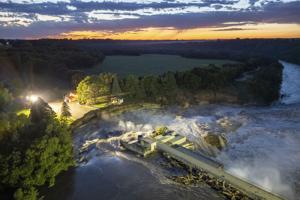

DES MOINES, Iowa (AP) — A Minnesota family that watched helplessly as their house tumbled into a flooded river that eroded the bank where the home was perched say as soon as it’s safe, they will reopen their nearby store, known for pies and burgers.
The Rapidan Dam Store remained standing Thursday, but the house where its owners grew up toppled into the swelled Blue Earth River near Mankato two days earlier. Flooding in the area was improving, and the National Weather Service was now predicting that flooding downstream is unlikely to be devastating.
“We don’t know what will happen,” a post on the store’s Facebook page said Wednesday night, adding that it’s been a hard experience. “The Dam Store has not sold its last burger or sold its last slice of pie.”
Hundreds of flood-damaged or destroyed homes elsewhere in the upper Midwest are among the first property casualties of extreme weather gripping the region as floodwaters move south.
Meanwhile, severe weather ravaged other parts of the country, including the Northeast where two people have died.
A man in Connecticut and a man in New Jersey both died from fallen trees. Strong storms raked parts of the Northeast late Wednesday into early Thursday, initially leaving some 250,000 in the region without power.
In western Pennsylvania, the storms likely spawned at least three tornadoes, according to the weather service. The suspected twisters touched down in parts of Allegheny and Westmoreland counties, and crews were headed there Thursday to view the damage. The storms also brought heavy rains and gusts of up to 70 mph (113 kph) to the area, downing power lines and trees and damaging some homes and other structures. No injuries were reported.
A swath through Nebraska, Iowa, South Dakota and Minnesota has been under siege from flooding because of torrential rains since last week, while also suffering through a stifling heat wave. Up to 18 inches (46 centimeters) of rain have fallen in some areas, pushing some rivers to record levels. Hundreds of people have been rescued and at least two people have died after driving in flooded areas.
In Iowa, more towns braced for floodwaters, but at least some caught a break. The west fork of the Des Moines River reached its crest early Thursday at about 17 feet (5 meters), where it will linger for a bit before the waters begin to recede. Humboldt County emergency manager Kyle Bissell breathed a sigh of relief at that news, noting that while the swollen river had taken its toll on several dozen homes, the threat of more damage had dwindled.
“They had a lot of time to prepare, and they did a great job,” he said of Humboldt homes and businesses.
Bissell said about 50 to 75 homes have reported minor damage, with some water seeping into their basements, lower than the 200 homes anticipated. Only a few unoccupied summer cabins appear to have sustained major damage.
A levee on Little Sioux River in Monona County, Iowa, was damaged by floods, but county emergency coordinator Patrick Prorok said the flooding was being contained by another segment of the levee system. The levee was the only one under federal operation reported to have failed in the region, according to the U.S. Army Corps of Engineers Omaha district.
In the coming days, Nebraska and northwestern Missouri are expected to start to see the downstream effects of the flooding. Many streams and rivers may not crest until later this week. The Missouri River will crest at Omaha on Thursday, said Kevin Low, a weather service hydrologist.
Some of the most stunning images have been of the floodwaters surging around the Minnesota dam.
Jessica Keech and her 11-year-old son watched part of the house near the dam fall into the river Tuesday night. They had often visited the area to see the dam and enjoy the pie from the Dam Store.
“It just kind of sucked it into the water. Just literally disappeared,” said Keech, of nearby New Ulm.
Blue Earth County officials said the river had cut more widely and deeply into the bank, and they were concerned about the integrity of a nearby bridge over the river. After the flooding subsides, the county must decide whether to make repairs to the dam or possibly remove it — with both options costing millions of dollars.
President Joe Biden spoke by phone with Minnesota Gov. Tim Walz to discuss the impacts to the Rapidan dam, and the Federal Emergency Management Agency had arrived in Minnesota, White House officials said.
Preliminary information from the weather service shows the recent flooding brought record-high river levels at more than a dozen locations in South Dakota and Iowa, surpassing previous crests by an average of about 3.5 feet (1 meter).
That has led to flooding that has devastated neighborhoods in some South Dakota, Iowa and Nebraska river communities, including North Sioux City, South Dakota, where flooding collapsed streets, took down utility poles and trees, and washed several homes off their foundations.
Numerous roads were closed because of the flooding, including Interstates 29 and 680 in Iowa near the Nebraska line.
This story has been updated to correct that the Des Moines River crested in Humbolt County early Thursday, not late Wednesday.
Collins reported from Hartford, Connecticut. Associated Press journalists Margery A. Beck in Omaha, Nebraska, Bruce Shipkowski in Trenton, New Jersey, Karen Matthews in New York, Summer Ballentine in Jefferson City, Missouri, John Hanna in Topeka, Kansas, and Lisa Baumann in Bellingham, Washington, contributed to this report.
